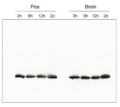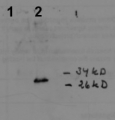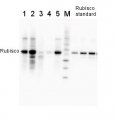Chlamydomonas reinhardtiiBelow you will find antibodies with confirmed or predicted reactivity to Chlamydomonas reinhardtii. Loading control for Chlamydomonas reinhardtii: PsbO (OEE1) or PsbP (OEE2). Accumulation of those proteins is a good measure of the amount of thylakoids, even in PSII mutants. PsbP (OEE2) accumulation is independent of the presence of PSII core subunits in Chlamydomonas reinhardtii De Vitry et al. (1989), Fig. 7B. Chlamydomonas strains can be purchased from Chlamydomonas center. Protocols and Technical Information • Support • Western Blot Video Tutorials |  |

AS06 142-33 | Clonality: Polyclonal | Host: Rabbit | Reactivity: A.thaliana, C. reinhardtii, C. vulgaris, C. sp. DT, E. crus-galli, F. arundinacea cv. Kord, H. pluvialis, H. spontaneum, H. vulgare, N. benthamiana, P. abies, P. banksiana, P. sativum, P. miliaceum, S. oleracea, S. tuberosum cultivar Taedong Valley, Synechococcus sp. PCC 7942 and PCC6803, T. salsuginea,
T.aestivum
Compartment marker of thylakoid lumen
Replaced by AS05 092

AS06 142-23 | Clonality: Polyclonal | Host: Rabbit | Reactivity: A. thaliana, Ch. reinhardtii, P. banksiana. , S.oleracea, T. aestivum

AS06 125 | Clonality: Polyclonal | Host: Rabbit | Reactivity: A. maritima, A. thaliana, B. juncea, Ch. reinhardtii, D. bardawil, D.salina, M. sativa, Morus spp.,O. sativa, Salicornia sp., S. tuberosum, winter triticale, Z. mays

AS06 123 | Clonality: Polyclonal | Host: Rabbit | Reactivity: Chlamydomonas reinhardtii, Physcomitrella patens

AS06 122 | Clonality: Polyclonal | Host: Rabbit | Reactivity: C.reinhardtii, purple bacteria (CRD1) and plants (CHL27) including A.thaliana, H.vulgare, N. tabacum, P.sativum, P. patens, Synechocystis sp. PCC6803
compartment marker of chloroplast thylakoid and envelope membranes

AS06 121 | Clonality: Polyclonal | Host: Rabbit | Reactivity: A. thaliana, H. vulgare, P. strobus, S. oleracea, Ch. reinhardtii, Synechocystis 6803 substrain PCC-M

AS06 119 | Clonality: Polyclonal | Host: Rabbit | Reactivity: A. thaliana, C. reinhardtii, C. quitensis Kunt Bartl, C. pumilum, H. vulgare, N. gaditana, N. tabacum, P. patens, S. martensi, Synechocystis 6803 substrain PCC-M, U. prolifera

AS06 117 | Clonality: Polyclonal | Host: Rabbit | Reactivity: Chlamydomonas reinhardtii, Chlorella vulgaris

AS05 085 | Clonality: Polyclonal | Host: Rabbit | Reactivity: [global antibody] for plant, green alga, animal and bacterial F-type ATP synthases
Benefits of using this antibody

AS05 084 | Clonality: Polyclonal | Host: Rabbit | Reactivity: [global antibody] for higher plants, algae, liverwort, cyanobacteria, diatoms | cellular [compartment marker] of thylakoid membrane
Benefits of using this antibody

AS04 038 | Clonality: Polyclonal | Host: Rabbit | Reactivity: [global antibody] for higher plants, Physcomitrella patens, algae, cyanobacteria, diatoms
Benefits of using this antibody

AS03 037 | Clonality: Polyclonal | Host: Rabbit | Reactivity: global antibody and compartment marker for higher plants, lichens, algae, cyanobacteria, dinoflagellates, diatoms
Benefits of using this antibody

AS01 017 | Clonality: Polyclonal | Host: Hen | Reactivity: [global antibody] for higher plants, algae, cyanobacteria | cellular [compartment marker] of plastid stroma
Benefits of using this antibody

AS01 016 | Clonality: Polyclonal | Host: Hen | Reactivity: [global antibody] for higher plants, algae, cyanobacteria and dinoflagellates
Benefits of using this antibody

AS01 003 | Clonality: Polyclonal | Host: Rabbit | Reactivity: Photosynthetic eukaryotes including A. thaliana, A. hypogaea, B. sylvaticum, , C. arietinum, C. sinensis, C. quitensis Kunt Bartl, C. sativa, H. vulgare, C. reinhardtii, L. esculentum (Solanum lycopersicon), M. crystallinum, N. tabacum, O. sativa, P. patens, P. sativum, P. vulgaris, S. alba, S. oleracea, T. aestivum, Triticale, Z. mays

AS01 001 | Clonality: Polyclonal | Host: Rabbit | Reactivity: A.thaliana, C.reinhardtii, cyanobacteria, Plectonema sp., Streptomyces sp.

AS03 030 | Clonality: Polyclonal | Host: Chicken | Reactivity: [global antibody] for plant and bacterial F-type ATP synthases
Benefits of using this antibody








